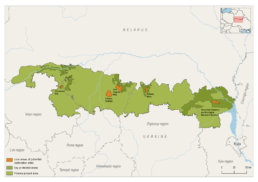Prypiat-Stokhid National Park
The national park protects a magnificent, more than 50-kilometer-long section of the Pripyat River valley preserved in its natural state. This is a landscape of waterways, characterized by numerous channels, quiet oxbow lakes, and vast floodplain marshes and meadows. It also encompasses the pristine, naturally preserved mouth where the Stokhid River flows into the Pripyat. To the north, the park shares a border with Belarus’s Radastaŭski Nature Reserve, creating a larger corridor for wildlife.
A defining feature of this area is the way the rivers constantly split and rejoin, weaving a complex web of branches, channels, backwaters, and oxbow lakes. This creates countless marshy and sandy islands. The result is a stunning mosaic of diverse wetland and forest habitats, which in turn supports an impressive array of plant and animal life.
This rich environment makes the park a critical hub for bird migration. During peak seasons, it becomes a massive gathering point, with between 120,000 and 150,000 migratory birds resting and feeding here at the same time.

Country: Ukraine
Area: 39,315.5 ha
National protection status: National Park
International protection status: Emerald Network (UA0000044) - Prypiat-Stokhid National Nature Park (38,940.0 ha); Ramsar Site (776) - Prypiat River Floodplains (37,567.70 ha); Ramsar Site (777) - Stokhid River Floodplains (10,000 ha); IBA (UA005) - Pryp'yat' river valley (12,500 ha).
857 species
of vascular plants recorded in the national park
26 key habitats
included into the Resolution No 4 of the Standing Committee to the Bern Convention are found in the area
333 species
of vertebrate animal species occur here
Land cover

Mires

Forests

Shrubs and meadows

Waterbodies and watercourses
Biodiversity and natural values

Habitats
The area is peculiar for the diversity and richness of biotopes of watercourses and reservoirs, mires and meadows. 26 endangered habitats requiring specific protection under the Bern Convention (Resolution No 4 of the Standing Committee to the Bern Convention) have been identified here:
Aquatic Habitats
- Floating Plant Communities (3150): Floating Salvinia natansmats (Water Fern), Floating bladderwort colonies, Floating Aldrovanda vesiculosa communities (Waterwheel Plant);
- Submerged Vegetation: Submerged carpets of stoneworts in mesotrophic waterbodies (3140), Mesotrophic vegetation of slow-flowing rivers (3260);
Wetland Habitats
- Mires and Fens: Transition mires and quaking bogs (7140), Rich fens, including eutrophic tall-herb fens and calcareous flushes and soaks (7130);
- Marshy Grounds: Beds of large sedges (normally without free-standing water), Moist or wet eutrophic and mesotrophic grassland (6440);
Woodland Habitats
- Deciduous Woodlands: Acidophilous oak-dominated woodland (9190), Oak – ash – hornbeam woodland on eutrophic and mesotrophic soils (9170);
Grasslands
- Dry heaths (4030), Inland Sand Dunes (2330).



Biodiversity
The area is of great importance for a number of species of flora and fauna. Over 70 local species are included into Resolution No 6 of the Standing Committee to the Bern Convention. The vegetation of the park includes 857 species of vascular plants. 41 plant species of the park are listed in The Red Data Book of Ukraine: the Lady’s Slipper (Cypripedium calceolus), the Floating Watermoss (Salvinia natans),the Sand Jurinea (Jurinea cyanoides), the Waterwheel (Aldrovanda vesiculosa),the Shrubby Birch (Betula humilis), and others.
The local wildlife includes 333 vertebrate species: 30 species of fish, 12 — amphibians, 6 — reptiles, 231 species of birds, and 60 species of mammals. It is of key importance as a nesting place for wetland species, as well as a migration corridor. Nesting here are globally threatened bird species as the Aquatic Warbler (Acrocephalus paludicola), the Great Snipe (Gallinago media), the Greater Spotted Eagle (Aquila clanga), and the European Roller (Coracias garrulous). Additionally, the area is of great importance for conservation of wetland bird species, such as the Short-eared Owl (Asio flammeus), the Bittern (Botaurus stellaris), the Black Tern (Chlidonias niger), the Whiskered Tern (Chlidonias hybridus), the White-winged Tern (Chlidonias leucopterus), the Montagu’s Harrier (Circus pygargus), the Corncrake (Crex crex), the Little Bittern (Ixobrychus minutus), the Bluethroat (Luscinia svecica), the Ruff (Philomachus pugnax), the Little Crake (Porzana parva), the Spotted Crake (Porzana porzana), the Terek Sandpiper (Xenus cinereus).
The area is inhabited by such mammal species as the European Beaver (Castor fiber), the Common Otter (Lutra lutra), the Murin des marais (Myotis dasycneme), the European Mink (Mustela lutreola). The territory is an exceptionally important habitat of a number of fish species: the European Weatherfish (Misgurnus fossilis), the Ziege (Pelecus cultratus), the Spined Loach (Cobitis taenia),the European Bitterling (Rhodeus sericeus amarus), аs well as of reptiles and amphibians: the European Pond Turtle (Emys orbicularis), the Crested Newt (Triturus cristatus), the Fire-bellied Toad (Bombina bombina). Rare insect species as follow are identified for the area: Dytiscus latissimus, the Scarce Fritillary (Hypodryas maturna), the Large Copper (Lycaena dispar).
The most important impacts and threats

Logging, dead wood removal

Meadows overgrowing with scrubs

Old drainage systems
The forest habitats and species are threatened by clearcut logging, sanitation felling, deadwood withdrawal, and forest plantation. The wetland ecosystems are degrading due to polder systems existing both in the national park and in its outskirts. The meadow ecosystems are overgrowing with shrubs due to abandoning of hay-making and grazing, as well as threatened by their transformation into arable lands. The entire national park is negatively impacted by household waste pollution, illegal hunting and fishing.
Protection and conservation needs
The area enjoys the conservation status of a national nature park. Zoning has been delineated with different restrictions imposed on economic activities, including strict protection zone where all kinds of economic activities are banned totalling 5,783.1 ha (14,7% of the area).
Among the measured that can enhance the efficiency of the conservation work in the area are the following:
- Compiling a detailed inventory of the conservation values;
- Their subsequent handing over under land-users’ protection;
- Consistent monitoring of the conservation values;
- Development of a management or conservation plan;
- Strict protection zone extension to at least 20% of the area.
Our activities in the area
Сameratraps were installed to study current distribution and abundance of big mammals in the project region.
Equipment, like GPS, office equipment, weather stations, etc. was purchased for the national park.
Since the beginning of the war, funds were raised for the support of Polesian PAs that have been directly affected by the war or need support in accommodation Internally Displaced People. Pripyat-Stokhid National Park was receiving regular financial support for covering expenditures like fuel, vehicle spares and maintenance, building maintenance, services (rent, telecommunications, etc.) and office supplies.



The project “Polesia – Wilderness Without Borders” is part of the Endangered Landscapes & Seascapes Programme and is funded by Arcadia. The project is coordinated by Frankfurt Zoological Society (FZS).

